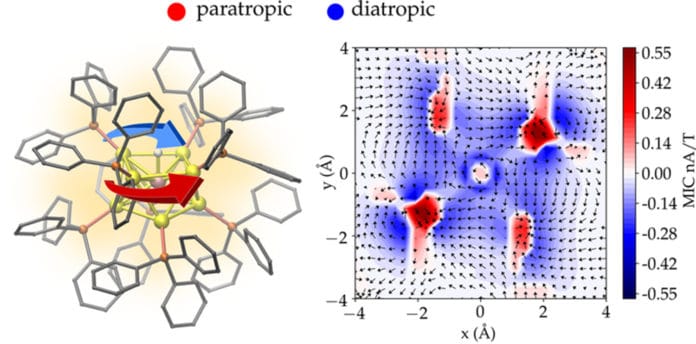Classical electromagnetism suggests that a particle that moves through an external magnetic field often experiences a force that makes the particle’s path circular. This is the basic law of physics that is used to design cyclotrons.
When nanometer-size metal particles are put in a magnetic field, the field prompts a circulating electron current inside the particle. The circulating current thus makes an inner magnetic field that goes against the external field. This actual impact is called magnetic shielding.
Using nuclear magnetic resonance (NMR) spectroscopy, it becomes easy to investigate the strength of the shielding. The internal magnetic shielding varies strongly on an atomic length scale, even inside a nanometer-sized particle. Understanding these atom-scale variations is possible only by employing the quantum mechanical theory of the electronic properties of each atom making the nanoparticle.
Now, Professor Hannu Häkkinen in the University of Jyväskylä, in collaboration with the University of Guadalajara in Mexico, developed a method to compute, visualize, and analyze the circulating electron currents inside complex 3D nanostructures. The method was applied to gold nanoparticles with a diameter of only about one nanometer. The calculations shed light onto unexplained experimental results from previous NMR measurements in the literature regarding how magnetic shielding inside the particle changes when one gold atom is replaced by one platinum atom.
The aromaticity of molecules is one of the oldest concepts in chemistry. It has been traditionally connected to ring-like organic molecules and their delocalized valence electron density that can develop circulating currents in an external magnetic field. However, generally accepted quantitative criteria for the degree of aromaticity have been lacking. Our method now yields a new tool to study and analyze electron currents at the resolution of one atom inside any nanostructure, in principle. The peer reviewers of our work considered this as a significant advancement in the field.
Journal Reference:
- Omar López-Estrada, Bernardo Zuniga-Gutierrez, Elli Selenius, Sami Malola, Hannu Häkkinen. Magnetically induced currents and aromaticity in ligand-stabilized Au and AuPt superatoms. Nature Communications, 2021; 12 (1) DOI: 10.1038/s41467-021-22715-x
